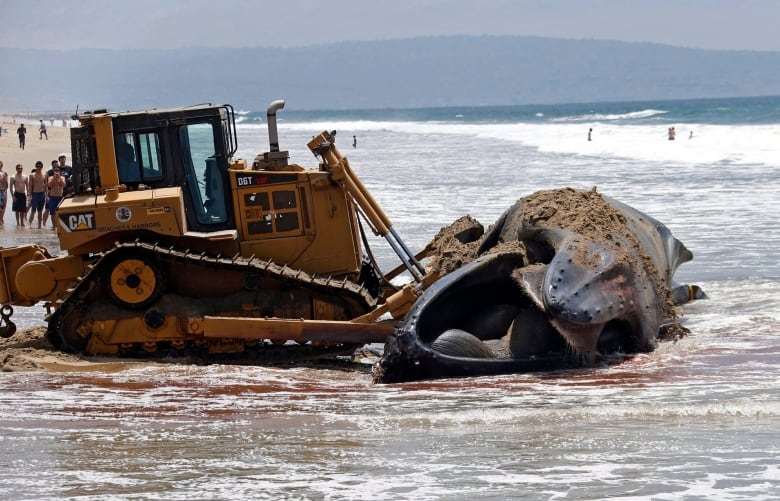[UPDATED] Wally the whale, a carcass that haunted California's beaches

[UPDATE: 2016-07-19]
The long tale of Wally the whale is finally over. The humpback whale's carcass, which had repeatedly washed ashore in California, was disposed of in a local landfill. The 14-metre whale was cut into pieces and taken away in three large dumpsters.
Wally's first brush with fame began last summer after aerial footage taken off the coast of Newport Beach captured her spraying water from her blowhole, creating the effect of a rainbow. It has been viewed more than a million times on YouTube.
But late last month U.S. fisheries officials confirmed it was Wally's 22-tonne carcass that washed up on a Los Angeles beach. In an effort to keep the carcass away from July 4th weekend crowds, they towed the body out to sea, only to have it wash up again...and again, and again, as many as 19 times.
Justin Greenman is the Assistant Stranding Coordinator for the National Marine Fisheries Service in California. He was on the scene with Wally the very first day. He spoke with As It Happens guest host Helen Mann from California on Monday:

Helen Mann: Justin, you were called down to dock the day after Wally was found. Can you describe what you found?
Justin Greenman: The scene when we got down there was a little chaotic. The whale had washed up the night before in the evening and then in the morning, a lot of the folks who live in the area were aware of it. When I arrived, the county dump truck was already positioned and ready to push the whale back out (to sea). We walked through the crowds and found Wally, who had been washed up on the beach was lying on its back. Unfortunately we weren't given much time to work with the animal because it was on a very popular beach going right into the Fourth of July holiday.
Even though it was a low tide, the bulldozer attempted to push the whale out, and the tow boats tried to pull but unfortunately they weren't able to get it much further than the swash. At high tide that evening they were finally able to get off the beach and tow it about 10 miles off that day.
HM: Now that wasn't the last though that people saw of Wally.
JG: Certainly not. When the whale was first stranded, we consulted with our float models and looked at the currents and the weather to see where we might need to take the whale in order to keep it from coming back to shore and at the time we suggested to L.A. County and the lifeguards to take it at least 30 miles offshore to make sure it wouldn't come back. Unfortunately they didn't have the equipment to do that and so Wally came back to shore quite a few times over the next couple weeks.

HM: how many times are we talking about?
JG: At least seven days in L.A. County, another seven days in Orange County. But the first day it stayed out there, floated around for about a day and they came back in the Santa Monica Bay,near L.A.X. It was towed about five miles off that evening came back to shore near Venice Beach, another very popular beach. So they tried towing it south this time, about 10 miles, and it came back, it floated for a couple more days after that though and then went offshore in Orange County where it started to approach the popular area of Newport Beach, where it was towed off again. It floated down near Dana Point, where those folks then towed it off a little bit further and then it floated down to San Clemente, where it was towed off again and then finally washed up on the beach near Encinitas on the 16th.

HM: And all this time while he's continuing to decompose?
JG: That's right, Encinitas is the first time that the whale actually came back to shore. Every other time the lifeguards and Coast Guards and everyone was communicating. So the whale actually didn't make it to land. It's much easier to tow when it's still floating.
HM: I've heard that the carcass can build up some significant gases is there any risk of Wally exploding?
JG: No. I wouldn't be worried about an explosion per se, but certainly the gases can build up. When we do a full necropsy on the beach, that's something we're doing. Not only looking inside but are also opening up these cavities letting some of that gas expel because when we tow the animal out then it will make it easier for the scavengers to eat it (and) make it easier for it to sink. So unfortunately because we had to keep this one intact, it still is very bloated and that body shape actually acts as a sail and can push the animal with the prevailing winds, which was back on shore.
HM: So what's the situation now?
JG: It's washed up on the beach in Encinitas, at this at this point, Wally has been laying on her back for the last 17 days so that part of her is very decomposed, bones are separating from flesh and so they're actually going to take it to a landfill.
HM: So they should have listened to you in the first place?
JG: We always provide suggestions. But it was their choice.
The interview was edited for length and clarity.